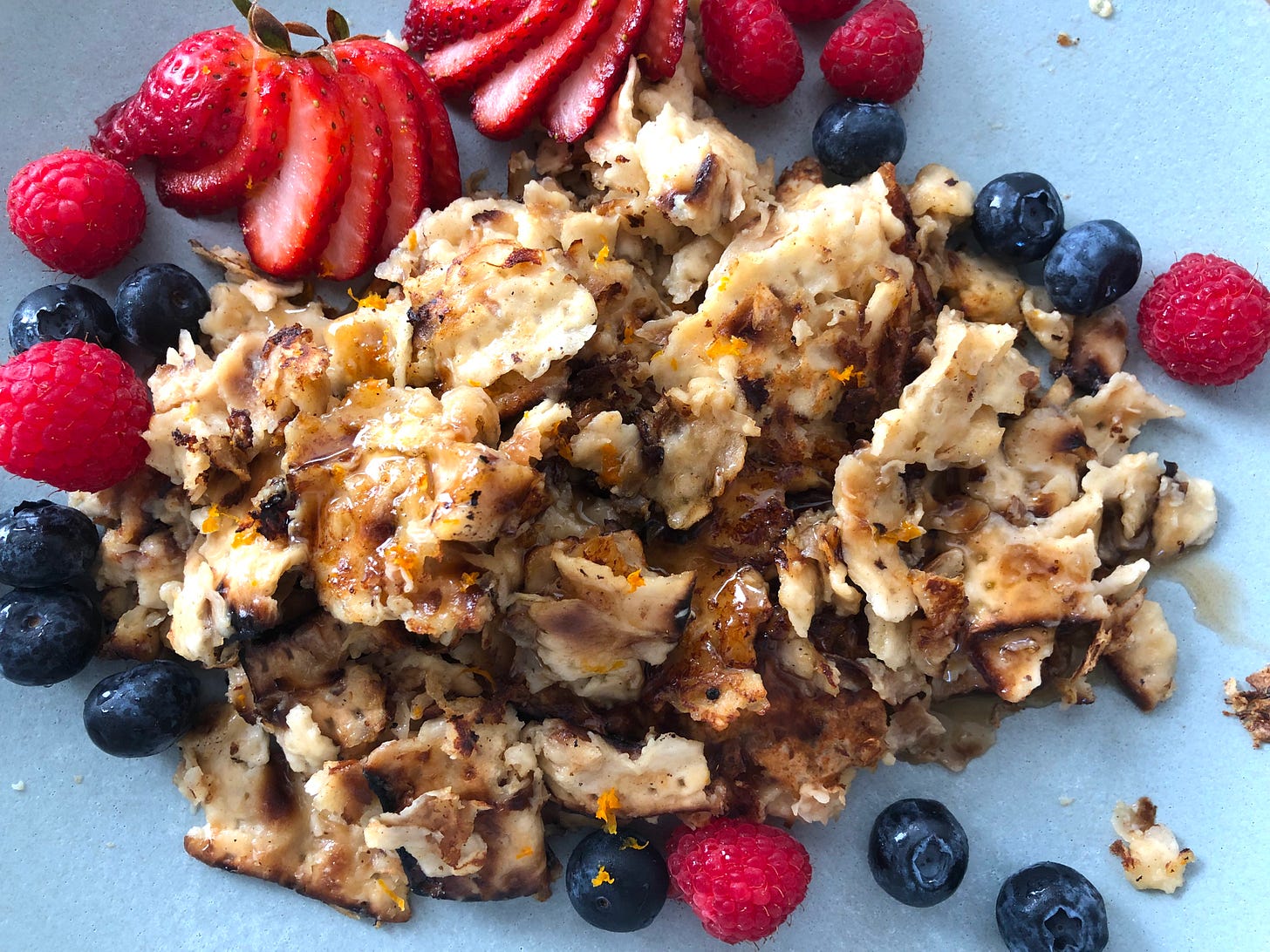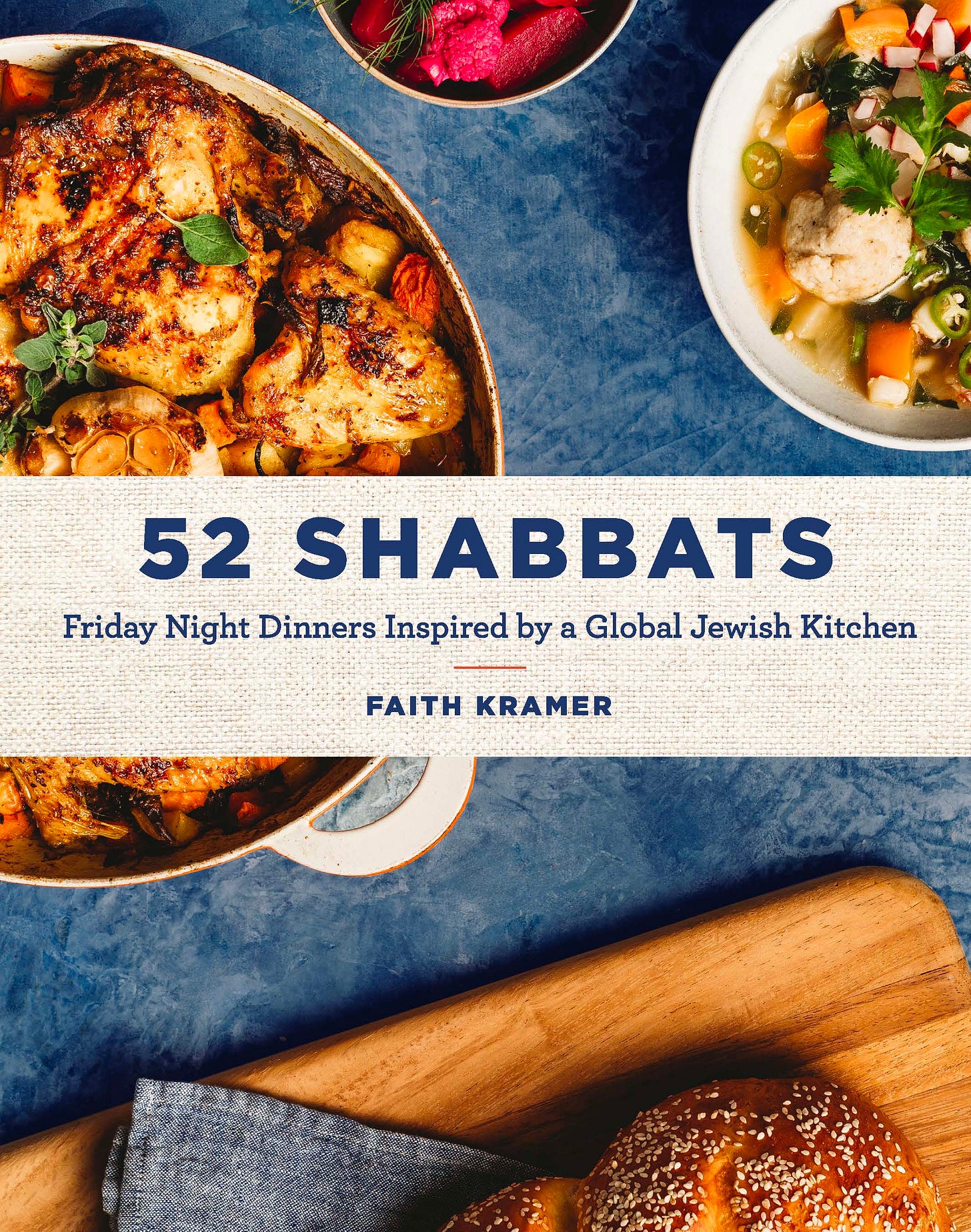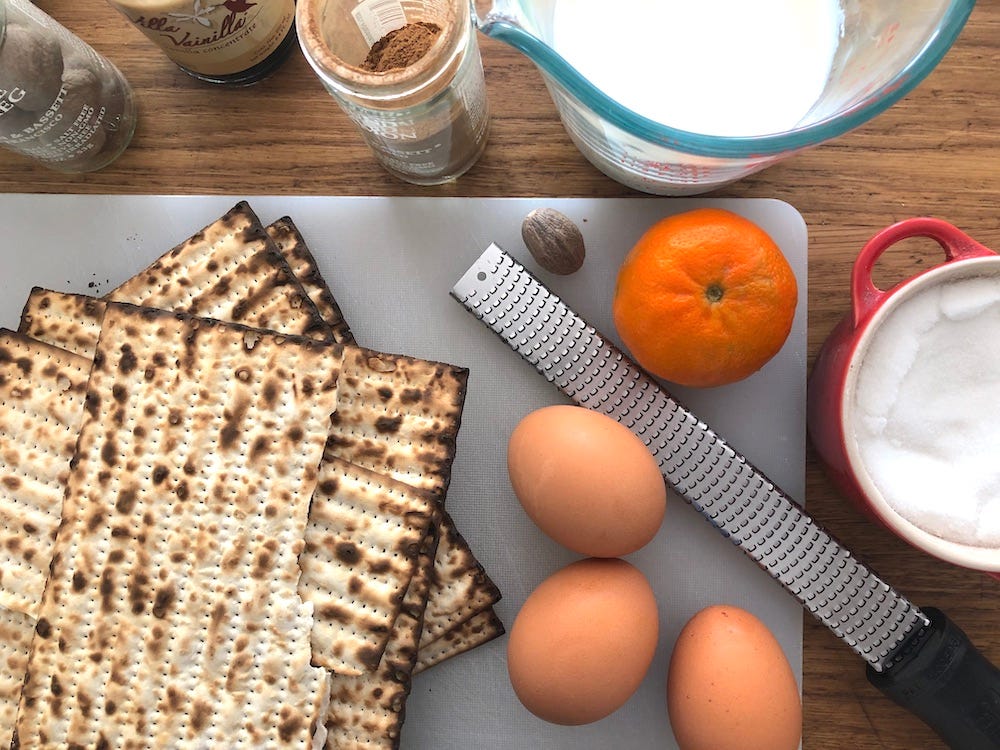Happy Spring! Last month, as Nowruz sailed past me unremarked upon (in this newsletter), I realized that I had not done enough planning ahead for the many Spring festivals and holidays we Californians celebrate this time of year—especially those that come with special food traditions. So over the next few weeks, I’m going to do better. First, we’ll have some recipes for Passover and Easter, and later in the month, we’ll take a look at how one family approaches fasting for Ramadan and celebrating Eid. (And next year we’ll get to Nowruz; I promise!)
Today, to start off this holiday extravaganza, I’m sharing a conversation I had with Faith Kramer, of Oakland, about Jewish foods and Passover dishes. Faith is a self-taught cook who, after a career in marketing, became a cooking columnist for The J— The Jewish News of California, where she shares the same kinds of recipes she makes for friends and family and develops new recipes based on her research into the foods of Jewish communities around the world. A few months ago, she also published her first cookbook, 52 Shabbats: Friday Night Dinners Inspired by a Global Jewish Kitchen (The Collective Book Studio).
Faith shared not one but two recipes that she makes for Passover, so I’ve included them both—a chicken dish roasted on a bed of tomatoes and matzo, and a rich custard matzo brei, based on traditional pain perdu. Both are at the end of the post. But first, here is my conversation with Faith, edited and condensed for clarity:
Faith Kramer
I moved to California in 1979. I grew up in suburban New York City. My grandmother served canned vegetables, my mother thought she was improving upon that by serving us frozen vegetables. So, I came to California, and the first thing I really, really loved was all the fresh vegetables. And the discovery of these fresh vegetables led to eating more seasonally, and it led to discovering vegetable-rich cuisines that appealed to me.
My grandma was a horrible cook. She had a few things she made well, almost by accident; like her brisket was great when she burnt the onions. My mom was an amazing cook, and she was extremely fearless in the kitchen. Not that she taught me how to cook, per se, but she taught me how to be fearless. I will tackle a new recipe or make a new recipe up for company. I don’t practice it first. I kind of got that from her.
Moving to California in ’79, I became acquainted with not just the produce but the bulk food and some of the mentality around foods here, and the focus on seasonality. I don’t think I’d cooked a piece of salmon before I came to California. I don’t think I ever made pesto before I came to California, because I had never seen so much fresh basil in one place at that price before. There’s all these firsts that happened in California.
One big influence for me was that, for about 14 years, I was a subscriber to a farm coop food box. It really, really taught me about California produce and eating seasonally. You know, when you get week after week of hard winter squash, and you have to figure out something new and delicious to do with it, that really pushes your envelope.
Another big thing is that I live in Oakland, and I have access to stores such as Berkeley Bowl and Monterey Market, and many other stores here that really showcase the best in produce, the best in meat. And I have access to interesting international grocery stores. There are so many different kinds of cuisines here, and they’ve all influenced me. Just the other day, I shopped a Korean grocery store, and before that I shopped a Spanish grocery store, a Mexican grocery store, and a Middle Eastern grocery store. And I stopped and got spices I needed from an Indian grocery store. So, I don’t necessarily cook authentic foods from all of these cultures, but all of these ingredients and tastes and flavors inform my cooking. And I think a lot of that is because I’m here, in California, and I have access to it all.
It was also in California that I became aware of other branches of Judaism, and how they ate differently than us. And it’s also in California that I became a mother and learned how to feed a family.
My husband likes stews and soups, so I do a lot of both. I tend to have a lot of odds and ends of vegetables in the house, a lot of odds and ends of protein in the freezer from different projects, and I tend to always have a really nice stock in the house. So, I just try to find ways to combine those. I really like cabbage in soup. I might make a sweet and sour cabbage soup, or I might feel like I want more of a tomato and curry flavor. Or I might feel like I want more of an Asian flavor with lots of ginger and some sesame oil. And I have all these ingredients in my pantry, just so I can do this kind of thing.
With stews, I have to say, I vary all over the place. It could be a Mexican or Asian oxtail stew, or it could be my take on tzimmes, which is a Jewish stew with dried fruit and sometimes carrots, sometimes sweet potatoes. I have a tzimmes in my cookbook that came out of my real life that has chipotle peppers, so it’s hot and spicy, and I actually have used that as a tamale stuffing sometimes.
My sons don’t live with me anymore—they’re adults and out of the house—and they have things they really like when they’re over. Maybe it’s Ethiopian food or Korean food that they like me to make, or, right now I’m making a lot of plovs, Central Asian one-pan meals with vegetables and chicken and rice. I think my family has come to expect dishes with international flavors, even if they’re not “authentic.” I like things with big flavors. I like things with visual interest—they look interesting as much as they taste interesting when you eat them.
When I’m having people over, if it’s something that’s kind of vaguely Jewish, I’ll do a brisket, because it feeds a lot of people, and chicken, because everyone likes chicken. If it’s a big crowd, I’ll usually end up with three entrees, because you always have vegetarians at your table, you always have people that don’t want beef, and then there’s always the people that are like it can’t be a holiday without brisket.
If I write a recipe that I identify as Jewish, it’s always going to be kosher, it’s always going to be accessible to anyone who’s Jewish. So, for my Passover recipes that you’ll find in The J, or elsewhere, I don’t put things in them that people may or may not eat because of religious restrictions. I keep them as generically Jewish as possible. But that hasn’t stopped me from developing a recipe for a vegan moussaka that you could eat at Passover that is also gluten free. The whole process challenges me to be creative and to be respectful, because I think the whole notion of what makes food Jewish is partly determined by the fact that for centuries and centuries, and for millennia, we have had dietary restrictions, and that has forced us to adapt and create food in response.
The dishes served at a traditional seder are a result of the kind of Judaism most Americans know and practice, and the traditions that are passed on, which come from a very Eastern European, Ashkenazi background. It’s because of our sort of historic, traditional viewpoint of what Judaism is. My husband used to beg us to be Sephardic at Passover, because they could eat beans and rice. We belong to the Conservative movement, and they now sanction eating like a Sephardic, because we’re all one family so we should have the same rules, kind of thing. So in my personal life I do do that.
At Passover, I do the orange on the seder plate. And that’s an interesting story, because many people associate it with feminist issues. And it has come to mean that, but it started as visibility of trans, gay, bi activism. So, we have that, and we have Miram’s cup to honor Miriam for finding the wells. Everywhere that they camped there was water, because Miriam would find the wells. And then we have developed our own family Haggadah over time, so it’s not the Maxwell House one I grew up with.
When you talk about the menu, I think that’s where it’s really different. First of all, I incorporate my love of mixing things together to get the taste I want. So, my brisket would probably be made with pomegranate molasses. You have this very American, classic Ashkenazi rich meat cut or accented by the flavor of this Near Eastern, Middle Eastern pomegranate molasses with its sweet-tart flavor. My chicken should be filled with vegetables, however I make it, and my vegetarian dish would often be something like an eggplant stuffed with herbs or mushrooms stuffed with quinoa—not anything I grew up with, just something I like to serve. And for dessert, you of course have the wonderful, wonderful fresh fruit we have here, and I like to do things with fresh fruit, like make a sorbet out of it.
Chicken on matzo is something I do all the time. Basically, it’s a bed of matzo and then you put your chicken pieces on them, skin-side up, and then you put garlic and onions, and you could put olives, you could put tomatoes, you could put whatever you want. And then you take a couple scoops of chicken soup stock—or you open a can of chicken soup stock—to moisten everything. And then you bake it in the oven. And the matzo becomes almost stuffing-like.
The other dish my family requests the most every Passover is my custard matzo brei. I was making traditional pain perdu—custard French toast—all year, and everybody loved, it but then came Passover. So, I adapted the recipe for a matzo brei. The matzo brei I grew up with was kind of dipped in water, dipped in egg, and fried up. It never was a dish I craved. But this is something different. You soak the matzo in this mixture of milk or cream and flavoring and sugar. I have cousins who live in LA who have actually driven up to our house during Passover so they could have our custard matzo brei. I keep boxes of matzo around all year because it’s the one thing we’ll make all year.
Custard Matzo Brei
Faith’s version of matzo brei is soft and French toast-like. First the matzo is soaked in warm water until it is soft, and then it sits in an egg and milk mixture for a full ten minutes, so that it can absorb the liquid. It’s also flavored with not only cinnamon and nutmeg but also a hefty dose of orange zest—what could be more California than that?
Makes 4-5 servings
Active Time: 10 minutes
Total Time: 25 minutes
10 whole matzo pieces
4 eggs, beaten
2 cups milk
¼ - ½ cup granulated sugar (to taste)
1 teaspoon vanilla extract (kosher for Passover)
2 teaspoons grated orange zest
¼ teaspoon kosher salt
¼ teaspoon ground cinnamon
Grating (or dash) of nutmeg
1 tablespoon of butter (or more, as needed, for the frying pan)
Cinnamon Sugar, jam, or syrup (optional)
1. Soak the matzo in a large bowl filled with warm water until it has just softened. Drain it well and break it into small pieces in a large bowl.
2. In another bowl, whisk together the eggs, milk, sugar, vanilla, orange zest, salt, cinnamon, and nutmeg.
3. Pour the egg mixture over the matzo. Let it sit for 10 minutes to allow the matzo to absorb some of the custard mixture, stirring occasionally.
4. Heat the butter in a very large frying pan over medium heat. Add the matzo mixture and fry it. (Be sure the matzo has room to fry, not steam, in the pan. If the mixture is too much for one pan, cook it in batches and keep it warm in a 250° oven. If you plan to hold the matzo brei for any length of time, slightly undercook it so it won’t dry out as it sits.)
5. Let the matzo brei mixture set in the hot pan for a minute or two, then use your spatula to break it into chunks and flip it. Keep flipping and breaking up the matzo brei every 1 to 2 minutes, until the custard mixture is absorbed but the matzoh is still moist.
6. Sprinkle the matzo brei with cinnamon sugar, if desired. Serve it by itself or with maple syrup, jam, or other toppings.
Chicken Baked on Matzo with Tomatoes and Olives
Faith’s recipe for chicken baked over matzo is full of Mediterranean flavors; the chicken is marinated in lemon, garlic, and lots of paprika, and it sits on a bed of tomatoes and olives. But the really genius part of the dish—the matzo under the chicken, which softens and takes on a stuffing-like quality as it cooks—could be used with any of your favorite roasted chicken recipes.
Serves 6-8
Active Time: 15 minutes
Total Time: 1 hour 15 minutes
¼ cup plus 2 tsp. olive oil, plus extra for pan
¼ cup lemon juice
2 tablespoons chopped garlic
1 ¼ teaspoons paprika, smoked or regular
1 teaspoon minced lemon zest
1 teaspoon kosher salt, divided
1 teaspoon freshly ground black pepper, divided
4 pounds chicken parts (with skin and bone)
1 small onion, thinly sliced
1 pound tomatoes, thinly sliced
5 pieces of matzo, broken into large pieces
1 cup pitted Greek olives, green or black
1 cup chicken broth
3 tablespoons chopped parsley
Mix 1/4 cup the oil, the lemon juice, garlic, 1 teaspoon of the paprika, the lemon zest, 1/2 teaspoon of salt, and 1/2 teaspoon of black pepper. Marinate the chicken in that mixture while preparing the other ingredients.
Cut the olives into the thinnest slices possible. Thinly slice the tomatoes.
Heat the oven to 450°. Grease a large baking pan (at least 2 inches deep).
Layer half of matzo pieces on the bottom of the baking pan. Sprinkle it with 1 teaspoon of the oil oil, 1/4 teaspoon of salt and 1/4 teaspoon black pepper. Repeat to make another layer of seasoned matzo.
Distribute the onions evenly over the matzo, then scatter tomatoes and olives on top. Pour the chicken broth evenly over the ingredients. Place the chicken (skin side up) on top, spooning marinade over everything.
Loosely cover the pan with foil. Bake the chicken, covered, for 40 minutes. Remove foil, and sprinkle everything with ¼ tsp. paprika. Bake the dish uncovered about 20 minutes, until chicken has reached 165° at the thickest part (timing will vary). Sprinkle with parsley before serving.
More California Stories to Read, Watch, and Listen To
The L.A. Times has a super fun article about a collection of “edible jade jewelry” made from sugar and served at the Eagle Rock restaurant Chifa. Last month, Modern Farmer published a story about how the drought is affecting California’s rice farmers—and how it may drive some to relocate to other parts of the state. The San Francisco Chronicles looked into how environmentally sustainable seafood is, and which types have the best and worst sustainability scores.
On the audio front, two of my favorite cookbook authors, Kate Leahy and Andrea Nguyen joined forces with two other powerhouse cookbook authors, Molly Stevens, and Kristin Donnelly, to launch a podcast called Everything Cookbooks, where they give you a behind-the-scenes look at their work. And the coffee-focused podcast Roast! West Coast interviewed coffee roaster Chad Bell of San Diego.
Lastly, Six California Kitchens: A Collection of Recipes, Stories, and Cooking Lessons from a Pioneer of California Cuisine, by Sally Schmitt, came out yesterday. It’s a bittersweet book launch as Schmitt passed away last month, at the age of 90. The book is backordered pretty much everywhere, but it’s a beautiful volume full of stories and recipes and will be worth the wait.
Photos: Georgia Freedman, Courtesy Faith Kramer (2), Georgia Freedman







